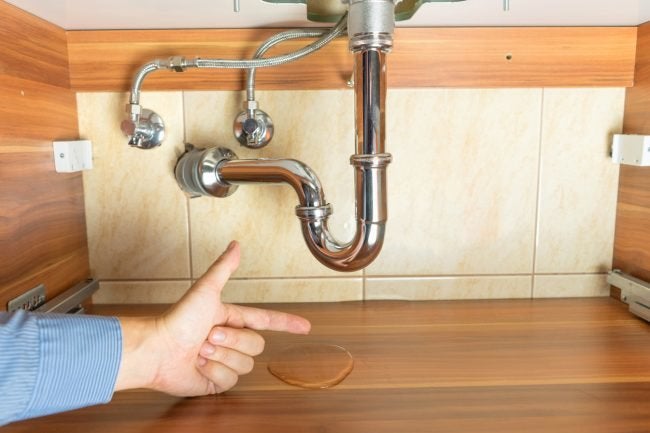6 Ways to Locate Concealed Water Leaks in Your Home
6 Ways to Locate Concealed Water Leaks in Your Home
Blog Article
They are making several great observations about Top leak detection hacks overall in this great article which follows.

Early discovery of dripping water lines can mitigate a potential calamity. Apart from saving you cash, it will certainly reduce the stress and also aggravation. The moment you discover a leakage, calling your plumber for repairs is the very best service. Some small water leaks may not be noticeable. If you can not detect it with your naked eyes, right here are some hacks that assist.
1. Check Out the Water Meter
Every home has a water meter. Inspecting it is a proven way that assists you find leakages. For beginners, turn off all the water sources. Make sure no person will certainly purge, use the faucet, shower, run the washing device or dishwashing machine. From there, most likely to the meter as well as watch if it will certainly alter. Considering that nobody is utilizing it, there must be no motions. If it moves, that indicates a fast-moving leak. If you find no modifications, wait an hour or 2 as well as check back once more. This implies you may have a sluggish leak that might also be underground.
2. Examine Water Consumption
If you find abrupt modifications, despite your consumption being the exact same, it implies that you have leakages in your plumbing system. An abrupt spike in your expense indicates a fast-moving leak.
On the other hand, a steady boost every month, despite having the same habits, shows you have a slow-moving leakage that's also gradually escalating. Call a plumber to thoroughly check your residential or commercial property, specifically if you really feel a warm area on your flooring with piping below.
3. Do a Food Coloring Examination
When it comes to water usage, 30% comes from commodes. If the color somehow infiltrates your bowl during that time without flushing, there's a leakage in between the storage tank and also dish.
4. Asses Exterior Lines
Don't forget to examine your outside water lines too. Needs to water leak out of the connection, you have a loose rubber gasket. One small leakage can lose lots of water and surge your water costs.
5. Examine and Evaluate the Circumstance
House owners ought to make it a habit to check under the sink counters and even inside closets for any kind of bad odor or mold and mildew development. These two red flags indicate a leak so timely focus is needed. Doing regular assessments, even bi-annually, can conserve you from a major problem.
Examine for discolorations and compromising as many devices as well as pipelines have a life expectations. If you presume leaking water lines in your plumbing system, do not wait for it to escalate.
Early detection of leaking water lines can alleviate a potential catastrophe. Some tiny water leakages might not be visible. Examining it is a guaranteed means that aids you discover leakages. One tiny leakage can squander loads of water and surge your water costs.
If you think leaking water lines in your plumbing system, do not wait for it to escalate.
How to Know If Your Home Has a Hidden Leak
Water Meter Reveals Inexplicable Water Usage
If you’d like to test whether or not there’s a leak somewhere in your home, you can do this using your water meter. Here is how to conduct the test:
Don’t use any water in your home for at least 30 minutes; this also means not turning on faucets or water-using appliances.
Go outside, and check your water meter for activity.
If your water meter shows that there was activity, even though no one was using any water, this proves that there is a leak in your home.Visible Mold or Mildew Growth
Leaks behind walls create moist, dark environments that allow mold and mildew to grow and thrive. Eventually, you might see mold growth forming on the wall closest to a hidden leak.
If mold is growing in an area that receives a high amount of moisture, such as a bathroom, it may simply be an indication that better ventilation is needed. However, if you see mold growth on a wall or the ceiling in an area where you would not expect, you probably have a hidden leak.
Musty, Mildew Odor
Sometimes you might not be able to see the mold or mildew that is growing as a result of a leak. However, the smell can give the problem away just as easily. If you catch a whiff of something musty, there’s a good chance that old water is collecting somewhere in your home that you can’t see.
Stained/Warped Walls, Ceilings, or Floors
When your home soaks up water, a variety of red flags can become visible, including ceiling stains, bubbling drywall, warped walls, and sagging floors. While these issues can be caused by excess humidity, they can also be signs that a pipe or plumbing connection has started leaking behind your walls.
Inexplicably High Water Bill
After a while, you get a general sense for what your water bill should be. If you own a pool or sprinkler system, your bill will tend to be higher during summer. However, if you receive a water bill that seems especially high, and you can’t figure out what caused it, then you may have a hidden leak somewhere that’s increasing your bill.
https://www.plumbingjoint.com/blog/2019/july/how-to-know-if-your-home-has-a-hidden-leak/

I stumbled upon that blog posting about Finding hidden leaks while surfing around the search engines. Sharing is caring. Helping people is fun. Thanks a lot for your time spent reading it.
Report this page